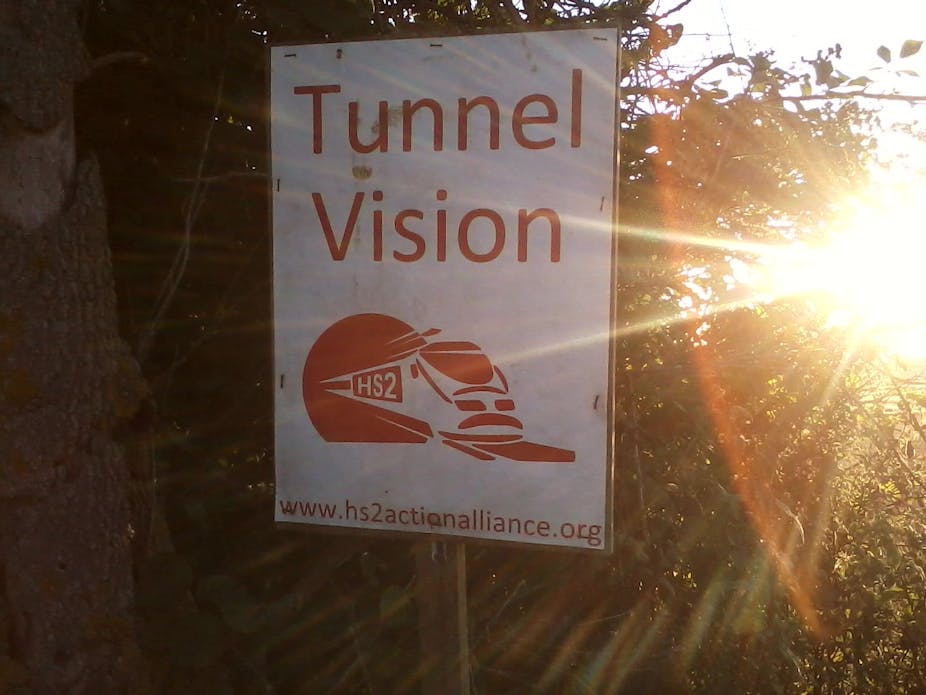The UK’s most ambitious infrastructure project is in trouble. Criticism of the High Speed 2 rail network has come from left and right of the political spectrum, with both the New Economics Foundation and the Institute of Economic Affairs challenging the government. The project’s costs are rising all the time: they now stand at around £40 billion while the economic benefits have been continually revised downwards.
The crux of the government’s problem is the need to find a justification for such a huge investment. Ultimately, this is really a question about what Britain will look like over the next century and what this implies for mobility.
Even if everything goes to plan, the first phase of HS2, between London and Birmingham, will not open until 2026. Since the Treasury assesses such schemes over a 60 year period of operation, justifying HS2 requires the government to produce a vision of the UK in the late 21st century. When we look at the flaws and gaps in this vision, we have to ask whether HS2 is a sensible investment.
Don’t look back
The government is failing to win the case for HS2 because its vision has not been sufficiently compelling or credible to persuade its critics.The Department for Transport has attempted to create a vision of the UK’s future through a process of modelling; taking selected observed trends from recent history and rolling them forward.
The most important of these is the demand for train travel. In recent decades this has consistently risen, leading the Dft to declare in its economic case for HS2 that there will be a continuing growth in long distance rail travel.
The past, however, is often a very poor basis for creating visions of the future. Consider the very same data the DfT uses to identify rising rail demand. Until 2005 domestic air travel (against which HS2 would compete) also grew consistently. Past trends would suggest no slow down, but it actually fell steeply in subsequent years. The extra security checks introduced in response to terrorism fears made it less competitive relative to other options, and demand fell accordingly.

An alternative future
The impact of increased security reminds us that what determines travel demand is the immensely complex outcome of intersecting social, political, technical and economic processes. Many potential developments over the decades to come could drastically change the case for HS2.
Some of these are already here. One major line of attack on the case for HS2 has focussed on its assumption that train travel is economically unproductive - that people do not work on trains. While this view might have been credible 20 years ago, technological advances, such as laptops and Wi-Fi, mean that a train carriage today functions as a mobile office. The Institute of Directors recently surveyed its members on this issue and found that only 6% do not work when travelling by train.
The same class of technology has the potential to change life radically in the coming years. Indeed, just such a vision is being pursued by the government as it funds research into the digital economy.
In the digital economy future, UK economic and social activity will have continued to move online. Interaction with others is increasingly virtual. People do not travel to occupy the same physical space but use technologies like video conferencing, and, further ahead, advanced virtual reality. Work becomes ever more distributed as the convenience and low cost of digital communications comes to outweigh the value of physical proximity. Manufacturing, too, becomes increasingly localised, as technologies like 3D printing and computer-aided manufacturing reduce the requirements for concentration to achieve economies of scale.
None of these developments are particularly “out there”. They are based on an analysis of current trends, in the same way that the DfT has looked into travel demand. As with growing demand for trains, none of these outcomes is inevitable, and neither are they a zero sum game – we might adopt all these practices and still find reasons to travel long distances in ever increasing numbers. If we do travel though, it is difficult to envisage how technology will not continue to blur the lines between stationary and mobile activity.
Today smartphones, 3G, tablets and laptops enable us to consume and produce information and entertainment on the move. Just ten years ago, most of these activities could only be done at home or in the office. If this process continues, the actual time spent travelling could become increasingly irrelevant, because what we do during that journey will be largely indistinguishable from what precedes and follows it. In such a situation, the logic of investing billions to shave 35 minutes off the journey from London to Birmingham becomes highly questionable.
The HS2 project hangs in the balance. Unless the government can produce more convincing visions about the mobility that will be required by the UK in the late 21st century, it has no hope of convincing the public that its money really is best spent on high speed trains.

